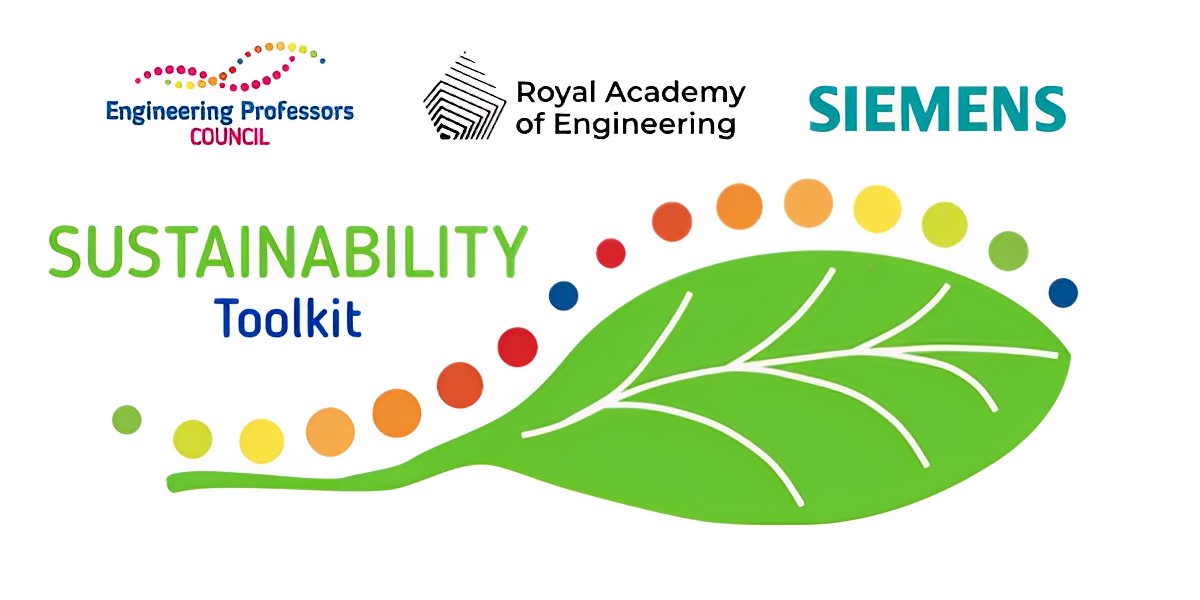Author: Dr Rehan Shah BEng (UCL), MSc (Oxf), PhD (UCL), FHEA, MIMA, MInstP (Queen Mary University of London).
Topic: Implementing sustainability into technical engineering curricula.
Tool type: Guidance.
Relevant disciplines: Any.
Keywords: Teaching or embedding sustainability; Mathematical problems; Curriculum; Higher education; Ethical issue; AHEP; Sustainability; Gender; Environment; Interdisciplinary; STEM.
AHEP mapping: This resource addresses three of the themes from the UK’s Accreditation of Higher Education Programmes fourth edition (AHEP4): The Engineer and Society (acknowledging that engineering activity can have a significant societal impact) and Engineering Practice (the practical application of engineering concepts, tools and professional skills) and Science and Mathematics (the ability to apply the knowledge, not merely understand it). To map this resource to AHEP outcomes specific to a programme under these themes, access AHEP 4 here and navigate to pages 30-31 and 35-37.
Related SDGs: See below for problems specific to SDG 5 (Gender Equality); SDG 6 (Clean Water and Sanitation); SDG 7 (Affordable and Clean Energy); SDG 9 (Industry, Innovation and Infrastructure); SDG 10 (Reduced Inequalities); SDG 12 (Responsible Consumption and Production); SDG 14 (Life Below Water); and SDG 15 (Life on Land).
Who is this article for? This article should be read by academics and educators at all levels in higher education who wish to integrate sustainability into the engineering curriculum within the typical mathematics-specific modules that are present. It will also help prepare students with the key graduate attributes and skills required by professional accreditation bodies and employers.
Supporting resources:
- Engineering Council Guidance on Sustainability.
- EPC Engineering Ethics Toolkit.
- The Accreditation of Higher Education Programmes (AHEP) Fourth Edition.
- The UK Standard for Professional Engineering Competence (UK-SPEC) Fourth Edition.
- UN 2030 Agenda for Sustainable Development.
- UN Sustainable Development Goals.
Premise:
Global challenges that call for environmental, sustainable and innovative solutions have consistently pushed us to be open to the changes and challenges within engineering education (Graham, 2012; Graham, 2018; Crawley et al., 2014; Lawlor, 2013; The Royal Academy of Engineering, 2007). Despite the prevalence of the UN Sustainable Development Goals (SDGs) since 2015, several reports and studies (Mulder et al., 2012; Buckler and Creech, 2014; Lazzarini et al., 2018; Morrissey, 2013; Neubauer et al., 2017; Wals, 2014; Miñano Rubio et al. 2019) have noted that the incorporation of sustainability within universities finds the greatest barrier in the field of teaching, with curricula often failing to address key environmental and ethical issues. This situation reflects the need for educators to develop a toolkit of resource materials that can serve as a reference guide for the effective and systematic integration of sustainability into university engineering curricula (Thürer et al., 2018).
Basic principles for embedding sustainability and ethics:
The principles for integrating sustainability into mathematical problems and exercises within the engineering curricula share strong parallels to the embedding of ethical components, as documented within several guidance articles from the EPC’s Engineering Ethics Toolkit. Some of these include:
- Interweaving into existing course materials:
Much like ethics, integrating sustainability into science and engineering courses* is “largely a matter of providing context for what is already being taught, context that also makes the material already being taught seem “more relevant” (Davis, 2006, Miñano Rubio et al. 2019). The technique of “micro-insertion” described by Davis in the context of ethics can also be succinctly adapted for sustainability issues, in that these “are not add-ons; they work like an alloy, adding strength to the course without adding volume” i.e., they need not be perceived as components to be introduced in lieu of existing technical material.
*For specific examples, see the following guidance articles:
- Integrating sustainability into HE Robotics
- Integrating ESD into computing
- Integrating and assessing sustainability in ChemE Capstone projects.
- Integration in a seamless and organic manner:
The inclusion of sustainability aspects into mathematical problems does require a great deal of care, thought and gradual experience as it might be done in a seamless and organic manner, without appearing to be artificial or contrived. The focus should be upon how students are engaging with these themes and not merely upon introducing sustainability as an add-on component to be taught (Butt et al., 2022). Often this is avoided by ensuring that such concepts emerge naturally from the technical nature of the mathematics/physics of the problem itself i.e., through an enlargement of the context of a problem by aligning it to a realistic scenario (see examples below).
- Subjective and reflective aspects:
Another point worth noting is that the answers to the sustainability elements of a question will often involve open-ended discussions and will most certainly involve subjective aspects, prompting deeper reflection from both students and instructors (Paulauskaite-Taraseviciene et al., 2022). This is unlike the objective ‘right or wrong’ answers provided to the technical parts of the problem, therefore even the guided ‘solution sketches’ provided in some of the example questions below, should not be treated as exact and fixed in nature, in fact these may be altered, tweaked or modified on subsequent usage.
- Links with the UN Sustainable Development Goals:
A final principle to mention pertains to the identification and mapping of key sustainability concepts within problems to each of the different 17 SDGs as applicable (see examples below). By establishing direct links between the overarching themes emerging from the technical problems and the SDGs formulated by the United Nations as part of its 2030 Agenda for Sustainable Development, students will be able to acquire a much more holistic view of sustainability within the context of their technical learning in engineering disciplines (Zelinka and Amadei, 2017; Ramirez-Mendoza et al., 2020)
Examples of mathematical problems with embedded sustainability:
The following three example problems from Chiodo and Muller, 2023 with minor adaptations (as permitted under the Creative Commons License CC BY-SA 4.0), illustrate ways in which sustainability aspects can be integrated within traditional technical exercise questions found in engineering mathematics courses:
Partial solution comments have been included here for brevity, please refer to Chiodo and Muller, 2023 for full solution details.
Problem 1: Pipeline construction
Topic: Optimisation.
SDG mapping: SDG 7 (Affordable and Clean Energy), SDG 9 (Industry, Innovation and Infrastructure), SDG 14 (Life Below Water), SDG 15 (Life on Land).
An oil company wants to build a pipeline connecting an oil platform to a refinery (on land). The coastline is straight. The oil platform is at a distance of 13km from the coast. The refinery is on the coastline, a distance 10km from the point on the coast closest to the platform. Building the pipeline will lead to a cost of £90,000 per km at sea and £60,000 per km on land.
Calculate the optimal length for building the pipeline. What are the factors that need to be considered when providing a response to this question?
Solution comments: The cost-minimising path is given by Snell’s law and is an exercise in trigonometry and calculus. But who said we were optimising over cost? This is an assumption often engrained into engineers while they are students, but it need not always be the right way to optimise. How many decisions made by government agencies (often based on advice offered by mathematical consultants) use economics as the sole criterion for optimisation?
Economic actions almost always have externalities, such as possible damage to the environment (the pipe may go through a coral reef or protected habitat) or to existing infrastructure (it may go through a school or a site of archaeological significance). How could we mathematically model the environmental and human impact of laying this pipe? There are numerous factors to consider and students, much like policymakers would, should take a holistic view of these effects and at least be aware of, and question the implications of basing decisions solely on economic factors.
Problem 2: Environmental disasters
Topic: Differential equations.
SDG mapping: SDG 6 (Clean Water and Sanitation), SDG 12 (Responsible Consumption and Production).
A chemical accident took place near a small village in Peru. The region’s local water reservoir has a volume V. The inflow and outflow of the reservoir is given by the flow rate r. Let x(t) be the amount of mercury in the reservoir at time t. Assume that the reservoir was clean at the beginning i.e., x(0) = 0. Let C(t) be the concentration of mercury flowing into the reservoir.
a. Set up and solve a differential equation describing the concentration of the reservoir.
b. How can you use your solution to model repeated pollution (e.g., criminals dumping mercury near the reservoir every weekend)?
c. What are some relevant questions you can ask about the concentration of mercury in the reservoir?
d. Suppose that the polluter is caught and after some cleaning, the incoming water is clean. How can you use your model to analyse when the water in the reservoir will be safe again? How sure are you of your answer and how much does it matter?
Solution comments: This question is designed to show students that very simple mathematics can be used to model local environmental disasters, which can often be an example of how it may be used unsustainably. It teaches students to find good questions instead of merely answering someone else’s questions.
For part c), possible questions for students to consider can include:
- Will the pollution of the reservoir ever reach a dangerous level?
- What is deemed a “safe” level of mercury in the reservoir?
- How closely does the concentration of the reservoir follow the inflow of pollutant chemicals?
- Will the reservoir reach an equilibrium concentration of mercury?
For part d) for the sub question “How sure are you?”, students will need to explore what the ‘known’ unknowns are e.g., errors in the measurement apparatus, non-uniform mixing, samples taken in a very clean/dirty part of the stream or reservoir. They may also need to consider any ‘unknown’ unknowns e.g., other sources of pollutants, samples being tampered with accidentally or deliberately, etc.
For part d) for the sub question “How much does it matter?”, students should identify that we are dealing with poison in drinking water, so it matters immensely! They should understand that this is an estimate, which helps forecast when the water might be safe to drink (the only way to actually know is to thoroughly test it). This question helps students to realise that the mathematics is simply one part of a much bigger solution and should not be relied upon as a definitive answer to a question as serious as the safety of drinking water.
Problem 3: Simpson’s paradox
Topic: Probability.
SDG Mapping: SDG 5 (Gender Equality), SDG 10 (Reduced Inequalities).
In a particular admissions cycle, a mathematics department observes a higher success rate for male applicants than for female applicants. To investigate whether this is the same across he two sub-departments of Pure Mathematics and Applied Mathematics, the following year the department asks each applicant to give their preference for pure or applied mathematics (they are not allowed to be ambivalent) and records the resulting statistics as shown in Figure 4 below:
Total
| Applications | Successful | |
| Female | 300 | 30 |
| Male | 1000 | 210 |
| Applications | Successful | |
| Female | 270 | 18 |
| Male | 350 | 15 |
| Applications | Successful | |
| Female | 30 | 12 |
| Male | 650 | 195 |
Figure 4: Admission statistics for male and female applications to study mathematics
a. Compare the success rates for male and female applicants that prefer applied mathematics, prefer pure mathematics and their success rates overall.
b. What do you notice? Why is this possible? This is known as Simpson’s Paradox.
c. If possible, find the admission statistics by gender and mathematics preference (pure/applied) from your university’s mathematics department and see if the same phenomenon occurs.
Solution comments: The purpose of this question is to demonstrate Simpson’s paradox in which a trend appears in several different groups of data but disappears or reverses when these groups are combined. It also attempts to highlight the immense gender disparity in many mathematics departments around the world.
For part b) it is evident from the calculations in part a) that females with a given preference (pure/applied mathematics) have a higher success rate than males with the same preference, but lower overall. This is Simpson’s Paradox. The heuristic reason for why this is possible is that the largest male cohort (those that prefer pure) has a much higher acceptance rate than the largest female cohort (those that prefer applied). So, the overall acceptance of men is dominated by those who prefer pure, while the overall acceptance of women is dominated by those who prefer applied. This is a great lesson in why it is usually a terrible idea to take “averages of averages”.
The main purpose of part c) is not so much for students to redo the calculation (it is not a given that Simpson’s Paradox will always arise here), but rather to illustrate the immense gender disparity in many mathematics departments around the world.
Conclusion:
The aim of this article is to provide academics and educators in higher education with an insight into how sustainability concepts may be integrated into technical, mathematical problems prevalent throughout engineering curricula. This should hopefully motivate lecturers to design their own versions of similar exercises to embed within their own courses and help build on ongoing calls to enhance the restructuring of our university programmes to better prepare future engineers to tackle global sustainability challenges by drawing not only on their technical and scientific knowledge, but also on their creativity, ethical, professional and leadership skills.
References:
Lawlor, R. ed., (2013). Engineering in Society. Royal Academy of Engineering.
The Royal Academy of Engineering (2007). Educating Engineers for the 21st Century.
This work is licensed under a Creative Commons Attribution-ShareAlike 4.0 International License.
Any views, thoughts, and opinions expressed herein are solely that of the author(s) and do not necessarily reflect the views, opinions, policies, or position of the Engineering Professors’ Council or the Toolkit sponsors and supporters.
To view a plain text version of this resource, click here to download the PDF.





